|
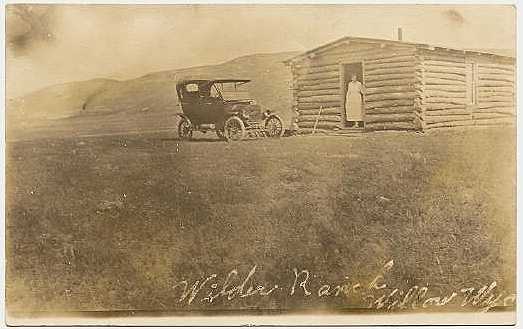
Wilder Ranch, undated
As previously noted, when the era of the large corporately-owned ranches ended there began an era of smaller farms and
ranches which relied on irrigation and "dry farming." Thus, the bulk of agriculture in Wyoming
has been family-owned and
operated businesses remaining in the same family for multiple generations. Those
ranches started as small homesteads with the ranch house often being a one or two room
log or stone cabin or a soddie, heated only by the stove and often with only a packed earthen
floor and a sod roof. For information as to soddies, see
Lusk.
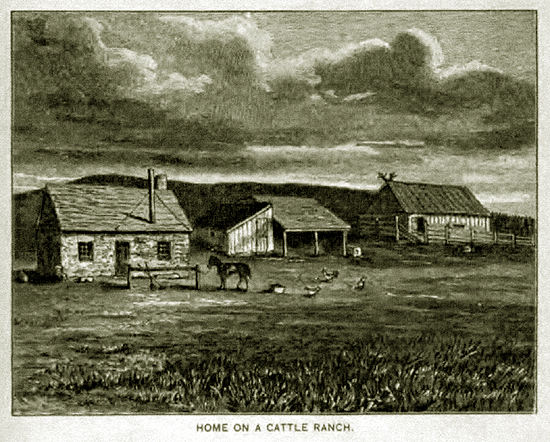
Cattle Ranch, 1887
The above illustration of William M. Thayer's 1887 Marvels of the New West, is described by
Thayer as belonging "to the best class of ranchmen's homes. It contains
two large rooms and a loft, accommodations that are found upon a few
ranches only."
Over the years through hard work and survival over the elements,
the houses would slowly be improved or replaced.
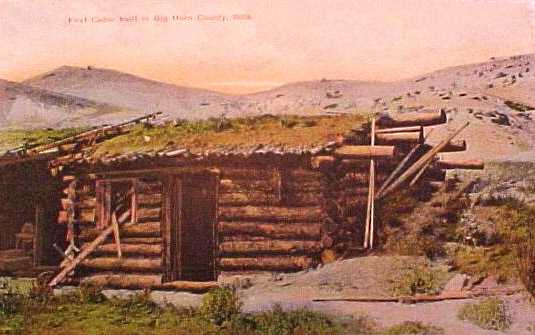
Early cabin, Bighorn County
As in the above view, cabins would often
be built into the side of a hill. This would provide extra insulation in the
winters and make the house cooler in the summer. Sometimes a root cellar would
be dug into the hill to help preserve food. In most instances the old cabins
would be abandoned. In a few instances, additions would be built onto the
cabin and ultimately a large house would appear without an outward sign of the
original cabin. Until the writer was about 12, the house we lived in started out as a stone
cabin built into the side of a hill. Slowly over the years the house had been
expanded with a second story and other additions. The only sign of the
orignal cabin were two windowless rooms behind the kitchen built into the side of the
hill. The back door and the main floor were on the second story, even with crest of the hill.
On one occasion the back door was left open and the sheep had invaded the back yard. The first
indication that the sheep were loose was the sound of the clip clop of their hooves in the main hall
upstairs.
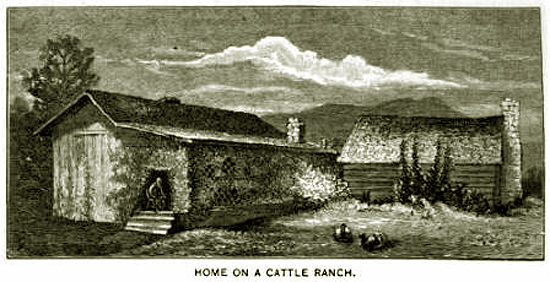
Home on Cattle Ranch, 1887
Even the above cabin is described by Thayer as being about average. Often the initial homes were mere dugouts as depicted in the
next illusration.
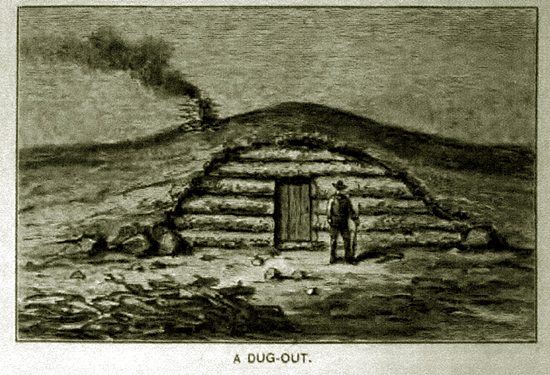
Dugout, 1887
Govenment lands were available to homesteaders. The requirement was that the homesteader had to be the
head of a family or over the age of twenty-one, a citizen of the United States or one who had declared
his intention to become a citizen, and not be the owner of more than 160 acres of land. Women could also be
homesteaders if she was the head of a family, single or dependent upon her own resources for support.
Homesteaders were required to settle upon the land within six months from making the claim. One was
required to maintain residence on the homestead for five-years before "proving-up" the claim. Properties were also
available by cash entry or under, as discussed later, the Carey Act by providing irrigation.
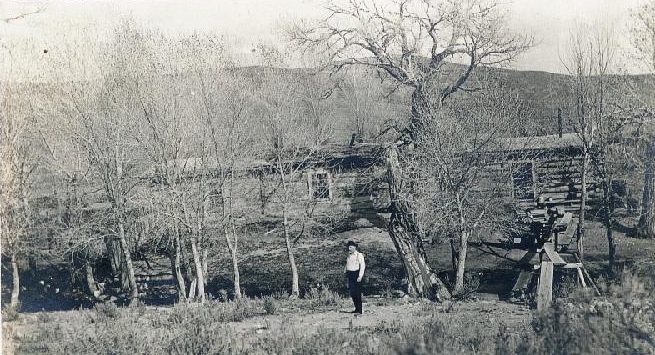
Pathfinder Ranch, 1907, Bonaparte Napoleon "Boney" Earnest in front.
Boney Earnest was a well known scout in Carbon County at the
turn of the Century. He had served as an army scout along with Tom Sun under Anson Mills in the
Powder River campaign of 1876. Mills flunked out of West Point in 1859 and notwithstanding
that he came from Texas served in the Union Army during the Civil War. His brother, W. W. Mills,
stayed in Texas as a Union spy. His other brother, Emmett Mills, caught the last stage out
of El Paso but was killed when Apaches attacked the coach. The Pathfinder Ranch, still in business, lies adjacent to the
Reservoir. On its lands is the grave of Ellen "Cattle Kate" Watson. Tom Sun became a rancher and owned the 3,000,000 acre Sun
Ranch near Devil's Gate.
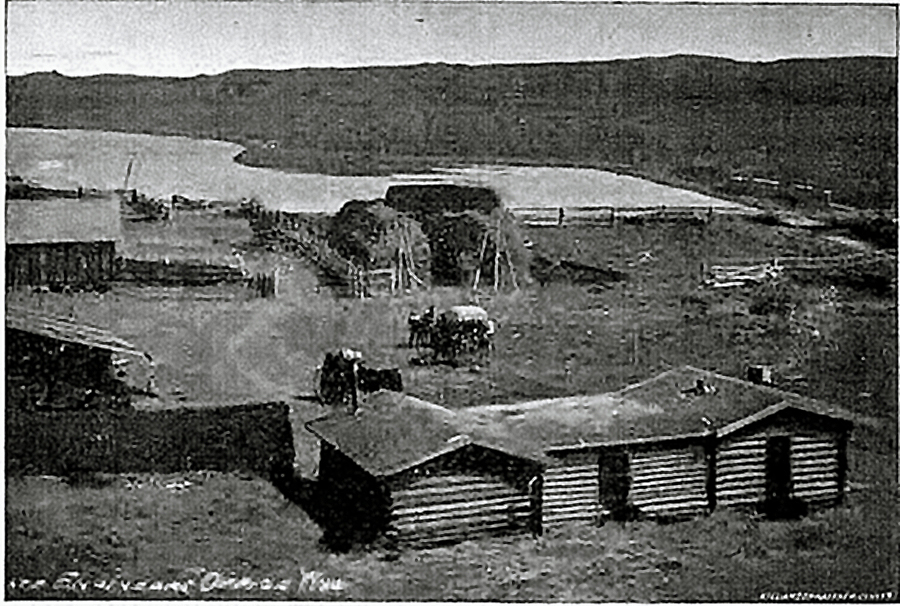
Typical circa 1898 homesteaded Wyoming ranch, Weston County, near Osage, 1898.
In the above photo, note the stacks of hay. With smaller operations, there was no longer reliance on open range. Hay
would be grown to tide the livestock over the winter. Thus, the seasonal work changed. Hay would be grown and in the
fall hay would be cut, raked and stacked for the coming months. As in the above photo, hay would
be stacked outside, usually in an area convenient for feeding the stock.
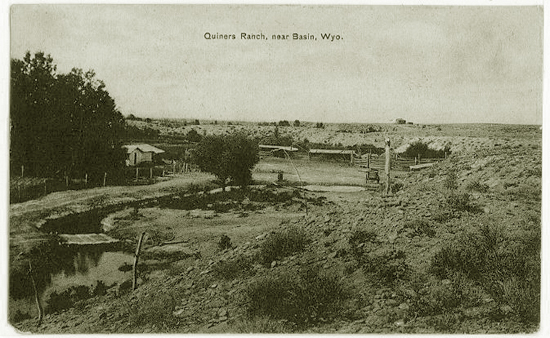
James A. Quiner's Ranch near Basin, 1908.
Next page: Irrigation, The Tallmadge and Buntin Land Company.
|